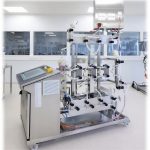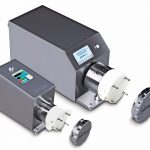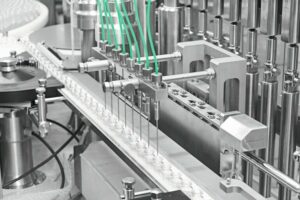When attempting to describe the processes that are inherent to biopharmaceutical manufacturing, adjectives like “complex,” “precise” and “pure” come to mind most often. That being said, the importance of those terms would appear to make words like “fast” and “quick” incompatible with the production of biopharmaceuticals. However, that is not necessarily the case. Actually, the most successful biopharmaceutical manufacturers are those who can reliably produce important drugs that are safe for human use while also getting them to market in a timely manner which maximises the earning potential of patent windows.
Today’s most widespread biopharmaceutical manufacturing systems involve handling, transferring, processing and purifying large-molecule drugs produced in living organisms like animal cell cultures, bacterial cells or yeast. This must be done in a liquid phase, with the handling of these materials performed by pump technologies that can reliably provide the volumetric consistency and accuracy, pressures, flow rates and low pulsation which are imperative for the process. Low shear, low heat input and material compatibility are likewise essential to protect the biological drug from harm.
The manufacturing process is generally separated into two main stages. During upstream processing, genetically modified cells suspended in liquid culture media are grown in bioreactors to obtain the desired product. The second stage – downstream processing – entails the separation and purification of the target molecule from the cells and by-products. Traditionally, permanent stainless-steel pumping and processing systems were used for these operations, yet the time and cost needed to operate, clean, maintain and quality control the system before the next production run could commence gradually became prohibitive. This led to the creation of single-use pumps featuring a disposable pump head and chamber that can be easily removed and replaced between runs, eliminating the time and cost necessary to revalidate the equipment in a stainless steel system.
Although single-use pumps were an undoubted boon to biopharmaceutical production – with positive displacement quaternary (four-piston) diaphragm pumps becoming a go-to technology choice for many manufacturers – there were still improvements that could be made as regards optimising their changeover times and simplifying the installation process. A breakthrough in this area came in 2017 with the development of a pump chamber replacing system that reduces the time to replace a disposable, single-use pump chamber to seconds.
Know your unit operations
Biopharmaceutical manufacturing is founded on various types of unit operation like tangential (TFF) or normal flow filtration (NFF), different chromatographic procedures and virus filtration. While each unit operation features its own set of operational criteria, they are alike in that they can only produce a viable, contaminant-free drug suitable for human administration if the manufacturer strictly adheres to an unbending set of operational parameters and structures.
Another common thread between these unit operations is their need for, and use of, a pumping technology that can satisfy their specific operational parameters. Again, these operations are processes in which the quaternary diaphragm pump excels, while competitive technologies such as peristaltic (hose), lobe, centrifugal and piston pumps may struggle to meet a series of rigorous product handling and transfer requirements.
The single-use solution
Some additional mention must also be given to the advantages achieved by utilising single-use quaternary diaphragm pumps in biopharmaceutical manufacturing. The main benefit of these pumps – whether deployed in traditional stainless steel or single-use setups – is their unique mode of operation: the four quaternary diaphragms are driven one after another by a connector plate, which moves back and forth out of its central position in a stroke generated by an eccentric shaft, with the length of the stroke determined by the angle of eccentricity. The four pumping chambers, which basically operate in the same way as the human heart, keep the product flow constantly moving forward in a volumetrically consistent, low-shear and low-pulsation manner.
The pump’s chambers moreover contain no rotating parts that are subject to friction, meaning there is minimum heat build-up that could compromise the product. Due to this mode of operation, the pumps cannot run dry, are self-priming and produce only minimal slip-induced shear. In addition, they combine low-pulsation, leak-free operation with excellent dry/wet suction-lift properties.
This turndown capability and range of quaternary diaphragm pumps is also unique in the biopharmaceutical industry. As products proceed from development to clinical trials and then commercialisation, proper scale-up is vital. In other words, the same pump may need to handle flow rates as low as only a few litres per minute in a lab while also being able to deliver commercial production flow rates of 50 m3/min or more.
Furthermore, quaternary diaphragm pumps are easily adaptable to single-use production configurations. A single-use pump enables manufacturers to essentially eliminate the often prohibitive cost of cleaning and validating pumps and systems. The result is a quicker and more cost-effective production process that nevertheless delivers preferred levels of product purity and sterility, with no possibility of cross-batch or cross-product contamination.
The core of the single-use pump is its product-wetted plastic pump chamber, which can be replaced as a complete unit.
The next step forward
While single-use pump technology solved the problem of how to reduce the time and costs for cleaning and revalidation after production runs, there was still more ground that could be ploughed when it came to shortening the pump head replacement time. The breakthrough came last year with the development and release of a pump chamber replacing system: the EZ-Set from Quattroflow Fluid Systems. The system does away with downtime during production changeovers, leading to the further optimisation of the product development timeline. It allows single-use pump chambers to be replaced in 30 s or less without either a torque wrench or any special tools and equipment. Pump chamber replacing systems can also be retrofitted on existing motor drives, so that upgrades are quick and easy. Replacing the pump chamber requires just five simple steps:
- Remove the pump’s pressure plate
- Take the pump chamber out of the ring drive
- Push the new pump chamber onto the ring drive
- Reinstall the pressure plate
- Slightly rotate the pressure plate to lock according to the markings
The markings on the side of the pressure plate, which show a minimum to maximum range, indicate the clamping force because it is important to have the proper level of compression on the pump drive. In fact, the pressure plate is so simple and easy to install that no physical strength is required – the days when you had to resemble a weightlifter to move it are long gone!
Online search: cpp0318quattroflow










